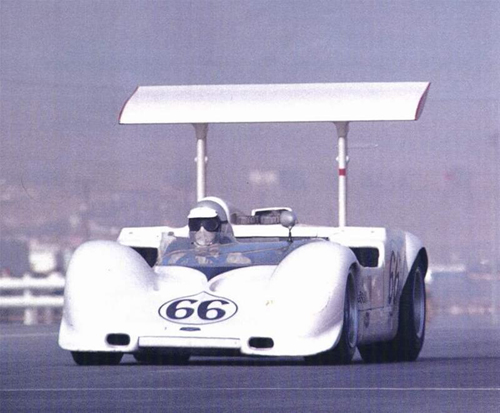Jim Hall ran his amazing series of Chaparral cars in the Can-Am from 1966 through 1970, but only took one race victory. But Halls contribution to the Can-Am was way bigger than his single victory. As an engineer, Hall was years ahead of his time. His Chaparral 2E of 1966 featured an automatic transmission which allowed him to develop an incredible adjustable tall aerofoil over the back wheels and mounted to the rear suspension struts. The wing sat way up high, out of the turbulent air created by the vehicles body.

The wing was driver actuated, flatten it out on the straight, then flip it up to increase rear downforce in the corners. So clever. And because it was mounted on the rear hubs, and not the bodywork, it applied its downforce to the rear wheels, not the bodywork.
There were two 2E's built for 1966, and driven by Hall and Phil Hill. And it was Hill who took the one and only Chaparral victory in heat 1 at Laguna Seca. At the end of the season at a non-championship race at Nassau, the rear wing failed on one of the cars with Hap Sharp at the wheel, and wrote itself off against a tree.
Hall ran just a single car in the '67 Can-Am. It was based on the 2E, but featured enough changes, including an alloy big block 427, but be given a new designation, the 2G. The 2G was raced by Hall throughout '67 and into 1968, until he collided with the rear of Lothar Motschenbachers McLaren M8A at the final round at Las Vegas, and went skywards, ending his career as a driver.
The rear hub mounted aerofoil was a design masterpiece. By 1968, other Can-Am teams were trying it, as were teams in F1, where there were multiple failures, forcing the FIA to ban the concept. Fortunately for Can-Am, their decision came too late for the wings to be banned for the '69 season, as several teams had developed them into their cars, and removing them could be even more dangerous. And so the '69 Can-Am would be the last in which these were used. By this stage most cars had them, and rolling start images from '69 produce the amazing sight of a field of low-slung big bore sports cars fitted with tall aerofoils mounted on spindly struts.
The concept was a good one, its just that some teams took it to its extreme, and didn't make the structure strong enough to withstand the forces places upon it.




 Reply With Quote
Reply With Quote

